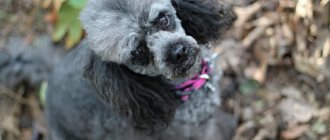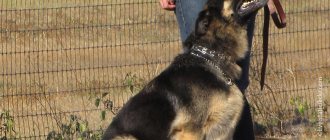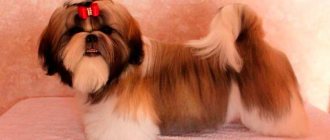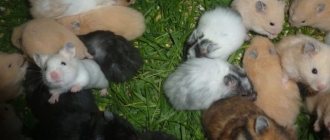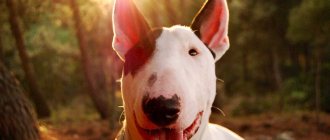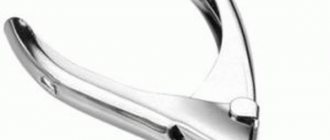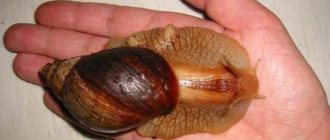The Djungarian hamster is ideal for those who, for one reason or another, do not have the opportunity to have a large pet. This type is one of the most popular. He is not whimsical, does not spread fur around the apartment and does not have the bad habits inherent in some pets. There are no problems with him. Ideal for those who do not have a large area or a lot of extra money. It is enough to select the smallest amount and the animal will delight your eye every day. Children love him very much and are interested in everything about Djungarian hamsters. You can accustom it to your hands and shoulder, after which the animal will be devoted to you every day. It’s just that at night a rustling sound can be heard from the cage; after all, this is a nocturnal animal.
Origin of Djungarian hamsters
The first mention of the Djungarian breed of hamsters appeared in the works of the German scientist P.S. Pallas in 1773. This researcher described the characteristics of the animal. In the middle of the 19th century. The first successful attempts were made to domesticate these representatives of the fauna. At the beginning of the 20th century. In Europe, keeping rodents at home has become popular, which has contributed to an increase in the population of these animals.
All hamsters currently bred in captivity are descended from a small number of wild-caught individuals.
This contributed to the emergence of mutations, incl. causing coat colors uncharacteristic for the breed. Subsequently, through breeding work, new colors were fixed at the genetic level.
Description of the breed
Djungarian hamsters are small, furry animals with a pointed muzzle and small ears. These creatures are active and inquisitive. Many people try to change their coat color, believing that such animals have better health. However, there are breeders who prefer pets of exotic colors.
Habitat
The homeland of Djungarian hamsters is the wormwood, xerophytic, gravelly-cinquefoil, and cereal-desert zones of North-Eastern Kazakhstan, Khakassia, and Western Siberia. Representatives of the breed also live in Altai. They can rarely be found in the steppe zones of the USA and Canada, but in these regions the wild population originated from pets brought from Europe, which people released into the natural environment.
Wild hamsters living in steppes and deserts are forced to obtain their own food, so their diet includes many types of food.
Rodents try to stay away from people, but when there is a lack of food in their natural environment, they raid agricultural land.
Coat color and length
Under natural conditions, the color of an animal's coat changes throughout the year. In spring and early summer, the fur on the back of the rodent is dark gray. At the same time, the abdomen remains beige. As the vegetation dies by the beginning of autumn, the fur acquires a pearl color.
In winter, the fur on the back becomes grey-white. This breed is characterized by a stripe of dark fur running along the spine and extending to the head. Changing colors helps animals protect themselves from predators. The length of the coat does not exceed 1 cm. There is a dense undercoat that protects the rodent from the cold. When kept at home, the color of the pet's fur does not change.
Color options for Djungarian hamsters.
Length and weight
Djungarians are small rodents whose body length is on average 7-15 cm. However, in the population there are smaller individuals that grow to 5-6 cm by the time of puberty.
The animal does not weigh the same throughout the year. In winter, it quickly loses weight, and in spring and summer it gains fat, even if the rodent lives in captivity and receives a sufficient amount of food every day. The weight of females is 19-36 g, and males - 19-45 g.
Character and lifestyle
In their natural environment, hamsters are nocturnal to avoid predators. Rodents dig holes or occupy others, often making nests in rock crevices. The animals spend most of the day in their shelter. Representatives of the species make provisions for the cold season.
Domesticated animals have largely retained the habits of their wild relatives. They are most active at night and can carry food into their house to stock up in case of a hungry period. These animals fiercely defend their territory. The fights between them are fierce.
The rodent is distinguished by its friendliness towards humans. The animal quickly gets used to its owner and begins to respond to its name. Loves stroking. You can accustom the animal to regular combing of its fur. Some pets fall asleep easily in your arms.
Djungarians love to be petted.
Lifespan
In their natural environment, these animals often die at a young age due to lack of food and attacks by predators. In captivity, they live on average about 2-3 years. However, if you provide the rodent with proper care, it can please its owner for 4 years.
Lifespan of a rodent
The number of weeks a hamster has already lived directly affects the remaining life expectancy, so it is important to purchase a young animal. In addition to age, the following factors are of great importance:
- variety;
- genetic characteristics;
- the conditions in which the animal was kept before purchase;
- nutrition rules;
- quality of care.
By providing the dwarf with good conditions and a balanced diet, it can live up to 3 years. In the wild, the animals exist for almost half as long, since many dangers await them in the wild. Life in a cage is characterized by tranquility, relieves forced hunger and colds, greatly increasing the ability of Dzungarian animals to live longer.
The Syrian varieties are larger than the Djungar varieties and are considered the largest among domestic rodents. There is no difference in determining the age of these breeds. The Djungarian brothers are just as small and light at 1 month. Only after passing the 30-day mark, they will differ in volume, and the weight of an adult Syrian hamster will be on average 115 g. Coat that is hard to the touch will tell about old age, smooth and soft - about youth and health.
Selection and arrangement of the cage
There are special requirements for the selection and arrangement of the cage.
It should contain:
- "sports" zone;
- feeding area;
- shelters.
Many breeders also recommend installing a “dry” bath inside the cage. Rodents love to rub against sand to clean their fur and remove dead hairs during shedding.
Requirements
Djungarian hamsters are small, but they require a lot of space. The minimum size of the cage bottom is 55x30 cm. However, it is better to have twice as much space. You can buy a two-tier cage with metal bars. The pallet must be plastic or wooden. It is unacceptable to have a mesh on the bottom, because... getting a rodent's claw or finger into the cell will cause injury. It is desirable that the tray be removable.
The hamster cage should be as large as possible, at least 55x30 cm.
In the cage, you must install a resting house made of hay, special labyrinths and holes of different heights and shapes, as well as several snags under which the pet can retire or hide food.
Sports area
The hamster has a fast metabolism, so if the animal does not move a lot, its fat layer will begin to increase. Excess weight is extremely dangerous for the health of these animals.
In natural conditions, rodents travel up to 10 km a day, so it is important to properly set up a sports area in the cage. Hamsters love to run on wheels. Its diameter must be at least 16 cm. It is better if the wheel is solid so that the animal’s paws do not fall between the bars.
Eating area
The arrangement of the eating area also needs to be given special attention. As a feeder, you can use a metal container up to 2 cm deep. It is important that it is heavy enough. In this case, the animal will not be able to turn it over. Hanging plastic feeders are also convenient. They are attached to the bars of the cage, so the rodent will not be able to move them.
If the hamster receives succulent food every day, it is not necessary to install a container of water.
However, when eating dry grains, the animal may feel thirsty. It is better to install a mounted drinking bowl so that the rodent does not turn it over and wet the bedding.
Carrying and necessary accessories
For a hamster, a simple metal or plastic carrier with a length of at least 15 cm will be sufficient. This device is useful when visiting a veterinary clinic. In addition, you can place the animal here while cleaning the cage.
A hamster carrier is an important thing that you can’t do without.
The required minimum of auxiliary accessories includes a walking ball. While wearing it, your pet will be able to safely walk throughout the house. In addition, it is advisable to buy a teeth sharpener made from compressed grass.
Cleaning
Wood pellets or dry grass can be used as bedding. The filler layer should be at least 3 cm. A removable tray will make it easier to keep the cage clean. Every day you need to remove the remains of succulent feed. It is recommended to change the litter once every 2 weeks. Hamsters often only defecate in one corner. Only the contaminated part of the filler should be replaced. Preserved supplies and the smell of the animal remaining on the bedding will help the rodent avoid stress.
Determination of gender
In the fourth week of life, the hamster begins puberty, and it is during this period that different-sex individuals are placed in different cages. How to determine the sex of a Djungarian hamster ? It is worth noting that the testes of males may not always be clearly visible at this age. Some males may suffer from cryptorchidism - that is, the testes do not descend into place at all, which means it is even more difficult to determine the sex of the rodent.
To determine sex, turn the hamster over on its back and look down its belly. In the female, the vaginal opening is very close to the anus; they are separated by a small patch of skin on which hair does not grow. In unformed females, you can notice weakly defined nipples, of which there should be eight. In addition, they do not have a bulge on their stomach, similar to a navel. This is a special gland with which males mark their territory.
Nutrition of the Djungarian hamster
It is believed that hamsters feel full within 10-15 minutes after eating. Then hunger forces them to eat again. If there is an excess amount of food, animals can overeat. If this happens regularly, the animal quickly develops signs of obesity. In the future, metabolic disorders and the development of diabetes are possible.
It is extremely important that the diet of captive animals is as close to their natural diet as possible.
Mode
Djungarian hamsters need to be fed 1-2 times a day. A balanced pet diet consists of 5-8% fats, 15-20% plant and animal proteins and 75% carbohydrates. Up to 80% of the menu should be represented by grains, juicy and dried grass, and up to 5% by permitted fruits. Vegetables are given to hamsters 10-15 g once every 2 days, and berries - 10 g once a week.
The Djungarian hamster needs to be provided with adequate nutrition.
Diet
It is important that your pet’s diet includes both dry and wet food. To grind down the teeth, the animal requires hard stems. Hamsters actively gnaw on all types of field plants, and especially love flowers. They eat dry grass, stems and roots. It is better to use dry grass as bedding: it will be a good feed for your pet. Fruits and vegetables should be a treat, not a staple food.
It is advisable to regularly feed the animals grain mixtures.
In addition to field grass seeds, their diet includes:
- oats;
- barley;
- rye;
- wheat;
- corn;
- sunflower.
The hamsters' menu can be diversified with grapes, blackberries, currants, rose hips and fallen fruits of all types of fruit trees. Under natural conditions, these rodents rarely eat nuts, because... their teeth cannot cope with the shell. However, if an animal comes across an already split specimen, it will eat its pulp. Periodically, dzhungarikas need to be given insects.
Composition of the Djungarian hamster's diet.
Dwarf hamsters
A fairly common species among breeders. Dwarf hamsters do not require much effort to maintain, and care is minimal. They weigh no more than 50 grams, and their height rarely reaches 10 centimeters.
The dwarf breed includes:
- Taylor's hamster;
- Campbell's hamster;
- Roborovsky's hamster (the owner of the smallest volumes).
Several other breeds:
- Long-tailed - body length does not exceed 10 cm, 6 of which are tail;
- Taylor - carcass length 7-8 cm, weight about 10 grams.
- Campbell's hamster - can reach 12 cm.
- Radde - has a height of up to 28 cm. It can mainly be found in the wild, not a common species as an ornamental animal.
Any breed of hamster does not require much effort in cleaning or care, and even a child can monitor the comfort of the fluffy one, the only condition is regular supervision.
Weighing the fluffy: how to do it?
Hamsters are happy, active animals, and if your pet is not hand-trained, then weighing a hamster is not an easy task that requires dexterity.
To do this you will need:
- kitchen scales
- small box or container
- tasty treats
First place the container with the treat placed in it on the scales in order to subsequently subtract their weight from the total weight of the hamster. Place the fluffball in a container. This way you can easily find out your pet's weight.
Weight control is necessary: this way you can see excess weight or sudden weight loss, which may indicate health problems.
If you change the homa's diet, you also need to monitor its weight: a decrease may indicate that the food is not to its taste and the animal is starving, simply hiding it.
Before purchasing a pet, decide which breed appeals to you, based on this, choose a house and the place where it will be located.
By following simple rules - watch your weight, keep the cage clean, spend time with your fluffy, you will get a reliable friend who will delight you and love you in return for a long time.
What I am a master at is talking incessantly about hamsters. I have three hamsters at home, and my husband has a pet rat. That’s how we live, the six of us eat, the six of us sleep :)
Source
Rules for caring for a hamster
Hamsters are able to independently monitor the cleanliness of their fur. It is enough to change the litter in a timely manner. You should check your ears periodically and, if necessary, carefully remove dirt. In addition, it is necessary to inspect the animal’s oral cavity 2 times a week to promptly identify overgrown teeth.
What not to do
Hamsters that live in steppe and mountainous areas are poor swimmers, so it is not recommended to bathe them with soap. This will not only be extremely stressful for the animal, but can also lead to the development of skin diseases. When cleaning the cage, it is not recommended to leave the rodent on a high surface. In nature, hamsters live on the plain, so they do not understand how dangerous falling is.
Health
A common disease in Djungarian hamsters is diabetes mellitus. To avoid health problems, your diet should not contain many monosaccharides, which are found in many fruits.
In addition, there are injuries, colds, dermatitis, and infection with external parasites. Any altered condition of the animal requires immediate attention to a veterinary hospital.
The Djungarian hamster is a funny animal, reviews of which are entirely positive. Pets are good for observation, but not particularly good for communication. With proper care, they live their short lives happily and serenely to the delight of their owners.
How to tame a Djungarian hamster
It is not difficult to accustom a dzhungarik, but there are several rules that, if followed, will ensure that your pet quickly gets used to its new owner:
- Before picking up the animal, you should gently stroke it and let it get used to the smell of a person.
- You can only try to lift a hamster that is awake, because... changing the position in space of a sleeping rodent will lead to its abrupt awakening and severe fright.
- You should not roughly grab the animal by the withers. You need to take it carefully, supporting it under the front paws.
- It is not recommended to make sudden movements near the animal or play loud music in the same room where the cage is located. This will scare the hamster and make it more difficult to tame it.
- You need to contact your pet every day so that it does not forget its owner.
The process of accustoming a dwarf to your hands is long and requires patience.
Requirements for “dwelling”
Caring for and maintaining a Djungarian hamster requires a minimum amount of knowledge. Only conditions close to the natural habitat will make the baby’s life comfortable and long.
It is better to get a glass or plastic terrarium as a place of residence - this way the animal will definitely not run away anywhere. There should be at least 0.15 square meters per rodent. m of usable area, that is, the length of the walls should be 30 and 50 cm.
The aquarium (terrarium) should not have too high walls. Firstly, it is impossible to provide normal ventilation in such a home. Secondly, the glass will sweat, and therefore will become an excellent place for germs to multiply, which can affect the baby’s health.
By the way, it is better to keep pets alone. In a couple or a large company, clashes often arise; animals injure each other and may even die in another battle for territory. Even if the Dzungarians behave peacefully, this does not mean friendly relations - most likely, they live in constant stress, expecting an attack at any moment.
Organization of space:
- bedding - sand, sawdust, they should absorb moisture well and absorb odor, you should not use cotton wool, newspaper, toilet paper and various rags;
- tray with litter for the toilet;
- a house with holes, you don’t have to buy it, you can create improvised holes using roots, twigs and all kinds of plastic tubes;
- wheel - selected individually;
- drinking bowl and feeder.
Methods for determining the age of a hamster
Often sellers who do not breed these animals do not provide accurate information about the age of the hamster. Selecting a young individual is quite difficult. There are a number of indirect signs that should be taken into account. First of all, you need to weigh the animal. An animal older than 3 months weighs more than 30 g. If the rodent is too obese, this indicates its old age.
In addition, you should pay attention to your pet's behavior. The younger the animal, the more active it is. An older hamster may look lethargic and sleepy most of the time. It is imperative to examine the eyes and fur. If the rodent is covered with soft fluff and has small bald patches, it means that it is about 2 weeks old. Cloudy eyes and dull fur are the main differences between sick and old individuals.
Dzungariki
Behavioral differences
The behavior of individuals is the most distinctive feature in determining their age. Young individuals run actively, play a lot, chew food and make squeaks.
Older individuals are calm, move little, rarely eat and often sleep.
Hair in the ear area
In newborn Djungarians, the inside of the ears is covered with white soft hairs, which thin out and disappear over time. The complete absence of fuzz on the ears indicates old age of the individual.
Eyes
In young individuals, the eyes are the same color, slightly shiny and not very protruding. If cloudiness is observed in the eyes, most likely the rodent is old or sick and will not last long.
Wool
The thicker the animal's fur, the older it is. Young individuals have a brighter, richer coat color and no bald patches.
The coat of newborn hamsters is softer and smoother. Hamsters that are 5 days old are completely hairless and will not have hair for another 2 weeks.
14 days after birth, the color becomes variegated, and the coat becomes thick and smooth. By the middle of a hamster's life, the coat will be tough. The thicker the fur, the longer the rodent lives.
Weight
Weight and size also indicate the age of the rodent.
If the hamster is more than 8 centimeters in length, then most likely it is more than 2 months old. At the age of 5-12 months, dzhungariki weigh approximately 40 g.
IMPORTANT! When purchasing a hamster, it will be enough to weigh it to determine its age. Leading veterinarians recommend purchasing an animal at the age of 5–12 weeks of life. At this age, individuals get used to the world around them and are not particularly afraid; they are able to feed on their own.
It is worth noting that the weight gain of animals stops at 4 months.
Dark spots
Another sign of determining the age of hamsters is the presence of age spots. They are located in the thigh area and resemble small seals. The color of the spots differs from the color of the skin. The more of them on the skin, the older the individual. Females have fewer pigment spots than males. The most noticeable ones are on the stomach and genital area.
Lifespan
The average lifespan of Djungarian hamsters is 2-3 years.
It is much more difficult for them to survive in the wild. This is due to dangerous factors found in nature: attacks by predators, poor tolerance to adverse weather conditions, eating at different times. Wild hamsters live 1.5 years.
Owners of domestic Djungarian hamsters surround them with care and attention, which is why the animals have a longer lifespan. With special and good care, you can extend their life to 3.5 years.
Reproduction of Djungarian hamsters
Hamsters become sexually mature at 1.5 months. However, breeders recommend breeding animals that have reached six months of age. For mating, rodents of opposite sexes are placed in a separate cage. At first you need to keep an eye on the animals, because... they might start a fight.
Pregnancy period
The female's pregnancy lasts about 3 weeks. After this, from 1 to 11 cubs are born.
Offspring
Hamsters are born blind and deaf. They are not covered with fur. For the first 5 days, the cubs are dependent on their mother. The female does not leave the offspring, warming them with her warmth. At this time, the young animals feed on milk.
Within 14 days, the cubs become covered with fur and begin to taste adult food.
Animal character
Dzungariks cannot be called too sociable. Having an independent nature, rodents do not need close contact with a human being. And if the owner wants to get an affectionate and sociable pet, he will have to make an effort and be patient.
Taming a rodent once and for the rest of its life will not work. If you don't talk to him for a couple of weeks, he will go wild again.
Therefore, if you have already decided to interact closely with your pet, then you need to do this constantly.
You should also follow your pet's daily routine without disturbing him during daytime sleep. Most likely, the main communication will occur in the evening hours, when the furry-legged furry is already awake, and the owner has finished all the day’s activities and can relax in the evening silence.
If you cannot find some little thing that is vital, look for a rodent in the house.
The thrifty nature of animals is evident in everything; they carry not only food to a safe place.
You should not put several animals in one cage.
Individual farmers by nature, Djungarians will definitely fight for territory. It is also necessary to timely separate the grown offspring from the mother.
Diseases of the Djungarian hamster
Djungarian hamsters are predisposed to certain diseases. They are often affected by parasites. In addition, they may have eye problems and endocrine pathologies.
Parasites
Hamsters often suffer from flea attacks. The presence of these parasites is indicated by the restless behavior of the rodent. In addition, animals can become infected with helminths. If signs of infestation appear, the pet should be treated with antiparasitic drugs.
Djungarian hamsters are often parasitized by fleas.
Conjunctivitis
Bacterial conjunctivitis is more common in hamsters. This disease is accompanied by the appearance of a small amount of pus on the eyelids. To treat ophthalmological pathology, the animal’s eyes should be washed with saline solution several times a day.
Dermatophytosis
Dermatophytosis most often develops after bathing or exposure of the rodent's skin to aggressive chemicals. The pathology is manifested by peeling skin and hair loss. Therapy should be carried out under the supervision of a veterinarian.
Cataract
Cataracts are more likely to develop in older animals. Clouding of the lens gradually leads to vision loss. This pathology in hamsters is incurable.
Long teeth
Hamsters grow teeth throughout their lives, so they must be ground down by hard food. If an animal's diet contains a lot of soft food, its teeth become too long and it loses its ability to feed. You need to visit a veterinarian to trim the overgrown incisors. To prevent this problem, you should install a chalk stone in the cage.
To shorten your hamster's long incisors, you need to consult a veterinarian.
Diseases
Alas, representatives of the Dzungarian breed sometimes get sick. At birth, many hamsters suffer from oxygen deprivation, so you need to know how to care for newborn babies. Injuries (fractures, dislocations, bruises, etc.) also occur, usually when the animal falls from a great height.
What else do you need to know about hamster diseases, what are they?
- Diabetes. Djungarians suffer from malnutrition more often than other breeds. To prevent illness, you need to carefully consider your pet's diet.
- Colds. They occur if the fluffy dog is not dried well after bathing or left in a draft. Wet litter can also cause a cold. Djungarians also suffer from viral infections and can pick them up from their owner. To prevent diseases, take care to strengthen your pet’s immunity: give him fresh parsley leaves, lettuce, unsweetened apples, and vegetables.
- Eye diseases. Typically, cataracts in rodents appear closer to old age, but even a baby can get conjunctivitis. The phenomenon is typical for furry cats whose owners rarely tidy their cages.
- Skin diseases. If the animal's fur begins to fall out or dandruff appears, this is an alarm bell. Skin ailments can be caused by frequent stressful situations or individual intolerance to a substance.
- Tumors. They have an acquired or congenital nature. The mechanism and causes of tumor formation in rodents are not fully understood, so no animal is immune. It is only known that an abundance of fatty foods increases the risk of getting sick.
- Parasitic diseases. Caused by rat fleas and ticks.
As you can see, many diseases of Djungarian hamsters can be avoided by following the principles of proper nutrition and taking care of cleanliness in the home. But if your furry miracle does catch some kind of infection, you should immediately consult a veterinarian.
Djungarian hamsters are cute creatures with an unpredictable character. In order for the animal to be healthy, you need to take good care of it. Particular attention should be paid to the nutrition and sanitary condition of his home. If you take proper care of your pet, it will rarely get sick and will be happy to come into your arms!
